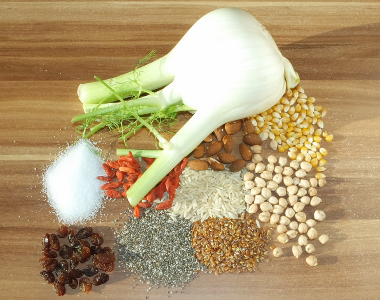Vegan Sodium Foods - Sodium-rich Diet

Sodium is an essential mineral. It is needed in the body for nerve conduction, muscle contractions, and regulation of water balance, among other functions.
For vegans, it should be no problem to meet their daily sodium requirement with the following list of sodium-rich foods.
Click here for the table of sodium-rich foods.
Salt
The most well-known source of sodium is table salt (sodium chloride), which consists of sodium and chloride. One gram of salt (sodium chloride) contains 390 mg of sodium 1. Converted to a teaspoon of salt, the body would be supplied with 2.3 mg of sodium, which corresponds to the daily upper limit of sodium for a healthy individual.
Despite its preserving and flavor-enhancing effects, salt should be used sparingly to avoid excessive sodium intake and its negative health consequences. Sea salt with added algae, which are rich in iodine, is especially recommended. Natural iodine is rather scarce in a vegan diet.
By the way, those who rely on unprocessed foods such as fruits, vegetables, and legumes have the lowest salt consumption 2.
Grains with Sodium
Whole grains naturally contain smaller amounts of sodium. Corn (35 mg per 110 g), spelt (8 mg), and brown rice (4 mg) are the best sources here. Pseudocereals such as kaniwa (30.5 mg), quinoa (5 mg), and amaranth (4 mg) also have even lower sodium content.
The table provides information on other types of grains that contain sodium.
Sodium-Rich Fruits
Above all, dried fruits such as goji berries (298 mg), mango (162 mg), apple (124 mg), and coconut flesh (37 mg) contain relatively high amounts of sodium.
Smaller amounts of sodium can be found in fresh fruits such as passion fruit (maracuja; 28 mg), agave (14 mg), papaya (8 mg), avocado (7 mg), and Nashi pear (7 mg). Almonds, which are considered nut fruits, also provide smaller amounts of sodium to the body, with 19 mg per 100 g.
In this table, you can find more sodium-rich fruits.
Sodium-Rich Vegetables
Sodium-rich vegetables include chard (213 mg), celeriac (100 mg), artichoke (94 mg), spinach (79 mg), beetroot (78 mg), carrot (also known as a "mohrrübe" or "möhre"; 69 mg), sweet potato (55 mg), and fennel bulb (52 mg).
You can find more sodium-rich vegetables in this table.
Nuts and Seeds with Sodium
Among the sodium-rich foods in this group are acacia seeds (102 mg), mustard seeds (92 mg), flaxseeds (30 mg), poppy seeds (26 mg), chia seeds (16 mg), and sesame seeds (11 mg).
The table shows other nuts and seeds that contain sodium.
Sodium in Legumes
Kidney beans and chickpeas each contain 24 mg of sodium per 100 g. Peanuts also have small amounts of sodium at 18 mg. Additionally, white beans (16 mg), lupin seeds (15 mg), and mung beans (15 mg) contain some sodium. Here is the table of sodium content in legumes.
Processed Foods
They usually contain a lot of salt, including to prolong the shelf life of the products. Vegan processed foods with sodium include smoked tofu (750 mg), sauces, salad dressings, ketchup, margarine, pickles, bread, rolls, and mineral water.
 VEGANALYZE
VEGANALYZE